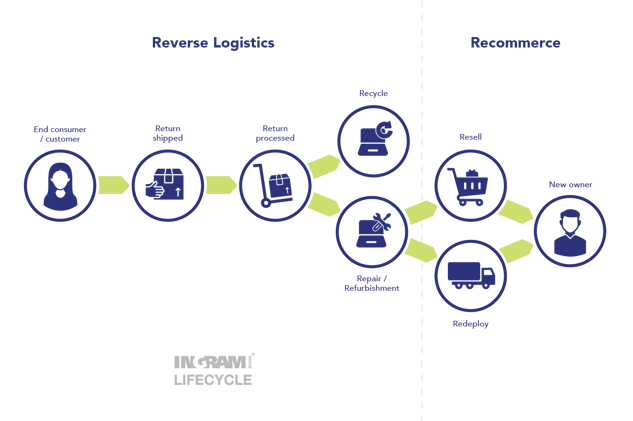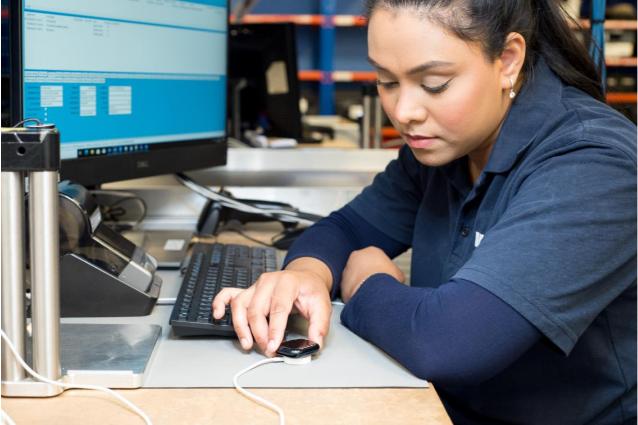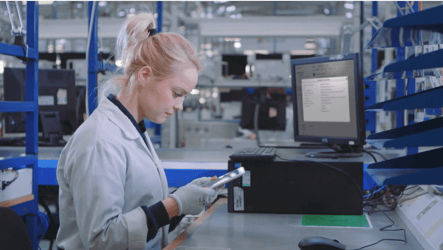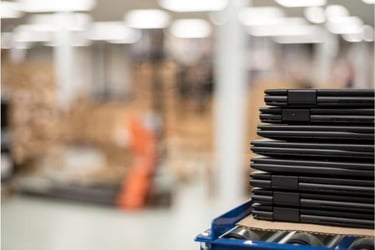Is sustainability at the forefront of your mind? Are you eager to make improvements to advance your sustainability goals? Failing to keep up with efficiencies to improve sustainability can lead to losing money, customers, and stakeholder loyalty.
Ingram Micro Lifecycle is a market leader in delivering reverse logistics solutions to varied technology companies, including manufacturers, retailers, enterprises, and network operators.
Over the last three weeks, we’ve introduced the three pillars of sustainability: environmental, economic, and social, demonstrating how your reverse logistics processes influence and impact these. Below, we discuss the actions you can take to improve your reverse logistics process to optimize it for sustainability.
What is reverse logistics?

Briefly, reverse logistics is the movement of products backward from an end user to the originating point of sale or supply, or further up the supply chain, such as the manufacturer. We’ve covered the definition of reverse logistics, including the steps within the reverse logistics process and types of reverse logistics in a previous article.
What are the three pillars of sustainability?
There are three identifiable categories, or pillars, that sustainability efforts and impacts can split into.
These are:
- Social, or fair labor and good health practices within reverse logistics roles
- Environmental, or eco-friendly practices that reduce the volume of raw materials needed for the use or manufacturing of a product, including recycling
- Economic, or the introduction of value recovery opportunities.
How to optimize the three pillars
There are numerous ways you can make changes across your reverse logistics processes to improve your sustainability within the three pillars.
Where you don’t have the infrastructure, resources, or technical know-how to enact these changes, sourcing a third-party reverse logistics partner may be a worthwhile investment.
7 ways to sustainably improve reverse logistics
Technology is constantly evolving and growing. The devices we hold in our hands and gadgets we use in our homes become ever-smarter. As such, your processes for handling these must grow and flex with their capabilities.
1. Innovate with automation
Look for innovative automation, software, and technology to streamline your processes, creating new or improved efficiencies. These enable a consistent approach across processes, completing activities across one set of criteria, rather than working at odds with each other.
While a technician’s input and years of experience are invaluable, automation removes human bias and subjectivity, and reduces the margin of error. It also alleviates some of the smaller, refined processes that technicians may have to complete, enhancing their health and safety.
Balance the mix of technology- and human-led processes to satisfy your employees.
Automation offers an improved turnaround speed, ensuring minimal customer downtime, getting them to a satisfactory resolution and back with a working product as quickly as possible.
These changes will save costs, improve turnaround speeds, and increase customer satisfaction. As you’re processing products quicker, the impact of depreciation reduces. This is important if recommerce is the next step, recovering the highest value from the used products.
Innovative processes and technologies will also reduce the amount of product waste you generate, as processes heighten your ability to repair and refurbish, rather than waste components.
- Social impacts: improves customer satisfaction and stakeholder trust, health and safety improvements for technicians.
- Environment impacts: minimizes product waste.
- Economic: reduces errors that impact cost, reduces the cost of acquiring new customers, minimizes depreciation from quicker turnaround speeds.
2. Be transparent
Providing timely but necessary updates to your customers enables them to feel part of the process and appreciated. It’s frustrating having to return a product for whatever reason or be without a product that they may have come to rely on.
They want to be aware of what’s happening and how it will affect them. Manage their expectations by keeping them in the loop.
But don’t provide too many updates. Decide what’s pertinent for the customer to know and keep them abreast.
Being transparent and providing visibility to your customers increases their trust in you and your service provision, increasing the likelihood that they become repeat customers, loyal to your brand.
Reporting on your sustainability goals and supplying metrics to your stakeholders will also help improve their bond with you and your products. Conversely, if what you report is negative, or portrayed negatively, you may lose trust and respect. This is important if NPS is measured as a KPI for your business.
- Social impacts: improved customer satisfaction and brand loyalty, stakeholder contentment.
- Environment impacts: By 2030, the internet could be responsible for almost a quarter of all greenhouse gas emissions. Keeping communications to a minimum through efficiency leads to a greener digital economy.
- Economic impacts: lowers the cost of customer acquisition.
3. Refine your policies
Regularly review any policies that are available to your customers, particularly around returns and terms and conditions of sale.
Staying on top of these enables you to minimize potential fraudulent returns or customers taking advantage of generous policies, for example, through bracketing. This is the purchase of variations of a product, perhaps in different colors, to keep one after receipt and return the rest.
There are 7 criteria to review your returns policy against that will ensure you can improve the customer journey, delivering a satisfactory experience, without suffering unnecessary financial losses, and minimizing packaging waste.
The outcome you decide for each of these criteria will determine the extent of your sustainability impacts.
- Social impacts: manages customer expectations, improves customer satisfaction and brand loyalty.
- Environment impacts: offering pick-up or drop-off (PUDO) collections of returns, less or more packaging/product wastage.
- Economic impacts: accepting fewer returns reduces processing costs and the cost of exchanges.
4. Close the loop on your supply chain
Focusing on a circular economy with your reverse logistics activities and minimizing the products that go to waste through re-use or re-sale of pre-loved products enables a closed-loop supply chain.
Offering sustainable disposition options for your products decreases your negative environmental impact and progresses your ESG efforts.
Consumers are becoming increasingly aware and conscious of their technology usage, and the footprint they leave on the environment. Demonstrating that you offer sustainable disposition for the products they purchase from you will enhance their satisfaction and improve their loyalty to your brand.
Retrieving used products from your customers, for example, through returns policies or trade-in schemes, provides you with a source of products that may contain a residual value. This value can be maximized through the utilization of repair and refurbishment processes before entering the products on the secondary market through recommerce.
Trade-in schemes encourage a segment of the market to bring their devices to you so they can benefit financially. These customers aren’t necessarily prior customers of yours, so your offering can attract and influence new customers.
- Social impacts: improved customer satisfaction, tackles eco-anxiety.
- Environment impacts: offers disposition options that reduce e-waste.
- Economic impacts: provides a revenue stream.
5. Introduce green transportation
Establishing PUDO points for your products helps limit the specific journeys logistics partners make to retrieve singular products. Through PUDO points, collections are aggregated to reduce vehicle emissions, fuel consumption, and costs of transportation.
These allocated points are typically in a convenient location where customers would likely visit, rather than make journeys for the specific reason of returning a product. They can also collect repaired products or receive exchanges through these points.
You can also invest in an electronic vehicle partner for the collection of goods.
- Social impacts: improved customer journey and satisfaction.
- Environment impacts: lowers fuel consumption and vehicle CO2e.
- Economic impacts: decreases logistics costs through aggregation.
6. Disposition considered in product design
When designing products, you should consider the end-of-life process and how repairs can be made. By considering this much earlier on, a process is already in mind for how the product will be disposed of when it no longer has a use, or how it gets repaired. This ensures the components used are easier to repair and refurbish, more environmentally friendly, and encourage lifecycle extension wherever possible.
It also enables robust customer guidance when they experience an issue with the product, giving adequate advice for the steps they should follow. Their eco-anxiety is reduced because they know the environmental impact of the product has been considered within its conception. They also know the product has been designed to last as long as possible, and don’t have the worry about negative waste impacts.
- Social impacts: improves customer experience and satisfaction.
- Environment impacts: increases the potential for lifecycle extension and reduces e-waste.
- Economic impacts: the lifetime customer acquisition cost linked is impacted by product reliability and after-sales support. The better their experience, the more likely they are to remain a customer.
7. Move returned products onwards
When you’ve retrieved a product, whether it’s faulty or unwanted by the user, you need to quickly process the product and find a way to move it onward so it’s not sat on your balance sheets, losing value.
One of the ways to do this is through recommerce. This enables you to sell the product, recovering the residual value while extending its useful life. The quality and grade of the product can be uplifted to improve the potential financial gains. The product moves on to the next owner, ready to be reused and re-loved.
An alternative method is if the product is leased to users. At the end of the contract, the product is returned to you for data wiping, repair, and refurbishing. It’s then ready to be leased out to the next user who pays a subscription fee for its use.
The next user can re-love the product at a lower cost than they would’ve had to pay upfront for a brand-new version.
You could also decide to make a charitable donation of either the physical product or the monetary sum of the recommerce sales. You no longer have a use for the product but other communities could still benefit.
- Social impacts: lower user cost of product ownership, philanthropy opportunities, decreased data risks.
- Environment impacts: e-waste minimized.
- Economic impacts: new revenue generated from residual value.
8. Compliantly wipe data-bearing products
The movement of products must encourage compliant data cleansing, removing any residual Personal Identifying Information (PII) of the previous user.
By holding OEM (Original Equipment Manufacturer) accreditations, you’ll have access to manufacturer-approved processes and software for the destruction of data. This software also provides an audit trail should your data handling be brought into question.
Demonstrating or explaining to customers the processes you follow to protect their data will boost their trust in your brand.
Being a victim of a data breach, either through selling/theft of products that contain residual PII or hacking, can lead to huge fines and reputational damage.
Sometimes it simply isn’t possible to wipe products, either because of their functioning state or the high level of sensitivity of the data.
- Social impacts: decreased data risks, improved trust in the brand.
- Environment impacts: a responsible, reputable program ensures these products are destroyed and disposed of correctly according to the law.
- Economic impacts: loss of customers and substantial fines if not adhered to.
9. Analyse data
Using the data you have available regarding returned or retrieved products enables the identification of patterns that may alert you to consistent problems.
This data can help you understand product issues, identify problems within the forward supply chain, product quality or user expectations, and spot trends in environmental data.
Working proactively in monitoring these patterns enables ample room to maneuver and course-correct if needed.
- Social impacts: improves customer satisfaction and experience.
- Environment impacts: improves waste reduction.
- Economic impacts: reduces the cost of errors and minimizes the rate of returns.
10. Partner with a reverse logistics provider
If this all seems a lot for you to focus on or detracts too much attention from your primary business function, finding a third-party reverse logistics partner may be the best choice.
Look for a partner that can provide lifecycle extension services via innovative repair and refurbishment processes. Understand how they strive to optimize reverse logistics and what benefits they can guarantee.
They should be able to offer you all the positive impacts above!
Optimize your reverse logistics for sustainability today
We hope this article has given you food for thought and tips for how you can optimize your reverse logistics processes to improve within the three pillars of sustainability.
Social impacts largely revolve around customer trust and their satisfaction, while improving technician safety within the workplace.
Environmental impacts see a reduction in the generation of waste, both within the products themselves and in their packaging.
Economically, you can make cost savings while tapping into a potential new revenue stream, realizing the potential residual value in used products.
If you’re looking to partner with a third-party reverse logistics provider to make your sustainability progress a success, Ingram Micro Lifecycle has a global footprint that can support a variety of industries with its technology use and sales.
Through innovative processes, we use automation to streamline processes and strive to reduce all wasted materials. Our skilled technicians have the expert know-how to get under the covers and interrogate common problems and issues to rapidly solve them, supplying products for swap stock or recommerce.
Get in touch with our team today to learn more about the reverse logistics packages we can provide and tailor to suit your unique needs.
Recommended reading:
- Reverse logistics: the environmental pillar of sustainability
- Reverse logistics: the economic pillar of sustainability
- Reverse logistics: the social pillar of sustainability
- What is reverse logistics
- 7 ways to optimize technology reverse logistics
- 9 key reverse logistics factors that affect value recovery
- 6 reasons to outsource rather than insource reverse logistics
- 4 things to look for in a returns management, recovery and recommerce provider













